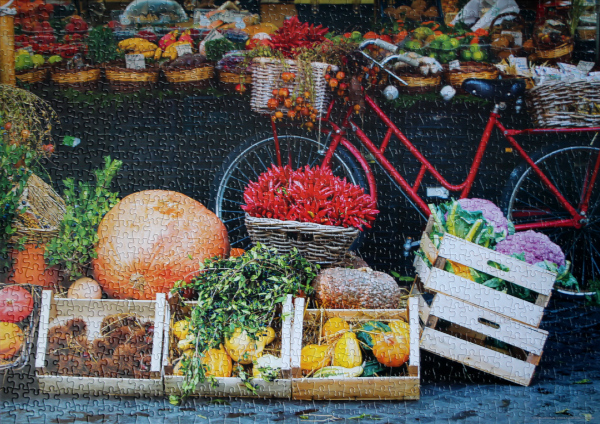
Size: 1000 pieces
Available for purchase on eBay
Dimensions: 48.26 cm x 68.58 cm
Manufacturer: The Canadian Group, #43407
Photographer: Studio Dagdagaz
Box: photo
Tag: vegetables
Puzzle: Blue Stove by Janet Kruskamp

Size: 500 pieces
Dimensions: 45.26cm x 35.56cm
Producer: Sure-Lox, The Canadian Group, Country Kitchen series, 2011, #42225-1
Artist: Janet Kruskamp
Puzzle: I have started this one with the blue regions: the door, the stove, the rug, and the chair. Window frame, white flowers in the vase, red apples, bowl on the table, the vase, the plaque on the stove, and the garden path are smaller self-contained regions. The flower garden and the light part of the floor easily fall into place, and the brown under the vase and all around and on the stove are the more subtle parts left over. Not a hard puzzle to do, it helps to have natural light at the end. The puzzle includes a shortbread cookies recipe and a red puzzle piece cookie cutter.
Stove: The Old English word stofa meant any individual enclosed space, such as a room, and ‘stove’ is still occasionally used in that sense, as in ‘stoved in’. Until well into the 19th century ‘stove’ was used to mean a single heated room, so that Joseph Bank’s assertion that he ‘placed his most precious plants in the stove’ or Rene Descarte’s observation that he got ‘his greatest philosophical inspiration while sitting inside a stove’ are not as odd as they first seem.
In its earliest attestation, cooking was done by roasting meat and tubers in an open fire. Pottery and other cooking vessels may be placed directly on an open fire, but setting the vessel on a support, as simple as a base of three stones, resulted in a stove. The three-stone stove is still widely used around the world. In some areas it developed into a U-shaped dried mud or brick enclosure with the opening in the front for fuel and air, sometimes with a second smaller hole at the rear. [Wiki]
Puzzle: Canning Day by Janet Kruskamp
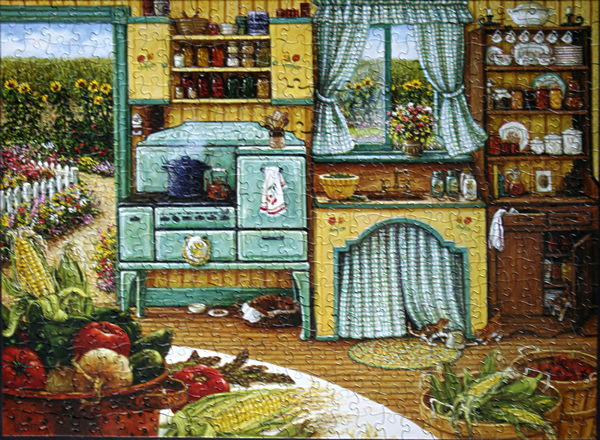
Size: 500 pieces
Dimensions: 45.26cm x 35.56cm
Producer: Sure-Lox, The Canadian Group, Country Kitchen series, 2011, #42225-2
Artist: Janet Kruskamp
Puzzle: A logical starting point are the checkered curtains, followed by the yellow batches of colour and the stove. Floor boards, white table, garden path and flowers, the patches of sky, and the vegetables make stand-alone regions that are easy to put together. Door frame and window frame logically fall into place. The rug, corn, and places under the stove follow, to leave only the cupboards and a few dark areas. Easy and fast puzzle to do. It also includes a shortbread cookies recipe and a red puzzle piece cookie cutter.
Canning: Canning is a method of preserving food in which the food contents are processed and sealed in an airtight container. Canning provides a typical shelf life ranging from one to five years, although under specific circumstances a freeze-dried canned product, such as canned, dried lentils, can last as long as 30 years in an edible state. In 1795 the French military offered a cash prize of 12,000 francs for a new method to preserve food. Nicolas Appert suggested canning and the process was first proven in 1806 in test with the French navy and the prize awarded in 1809 or 1810. The packaging prevents microorganisms from entering and proliferating inside.
To prevent the food from being spoiled before and during containment, a number of methods are used: pasteurisation, boiling (and other applications of high temperature over a period of time), refrigeration, freezing, drying, vacuum treatment, antimicrobial agents that are natural to the recipe of the foods being preserved, a sufficient dose of ionizing radiation, submersion in a strong saline solution, acid, base, osmotically extreme (for example very sugary) or other microbially-challenging environments. [Wiki]
Puzzle: Milllies Kitchen
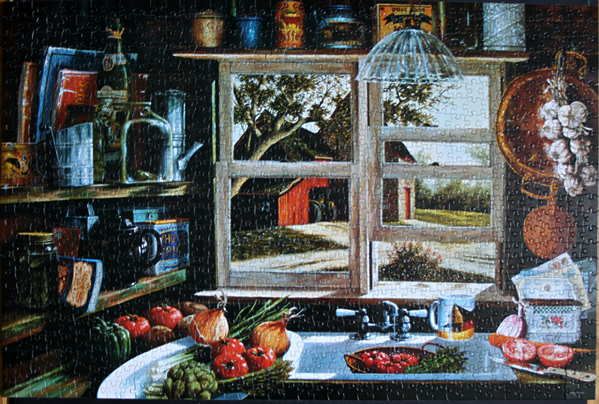
Size: 1000 pieces
Dimensions: 73cm x 48.57cm
Producer: Sure-Lox, The Canadian Group, Canvas Collection series, 2011, #44716-5
Artist: H. Hargrove
Puzzle: A rather detailed puzzle with many small regions of colour. White sink and plate, garlic and the orange objects behind it are probably the easiest place to start. The metal watering can, the light fixture, and the dark yellow/orange on the top shelf and the book in the lower left are several groups of colour that are easy to do. The tree and the red of the shed outside, followed by the window sill, leaves mostly dark regions to complete the puzzle. I found it quite an engaging one.
Asparagus: Asparagus has been used as a vegetable and medicine, owing to its delicate flavour, diuretic properties, and more. It is pictured as an offering on an Egyptian frieze dating to 3000 BC. Still in ancient times, it was known in Syria and in Spain. Greeks and Romans ate it fresh when in season and dried the vegetable for use in winter; Romans would even freeze it high in the Alps, for the Feast of Epicurus. Emperor Augustus reserved the “Asparagus Fleet” for hauling the vegetable, and coined the expression “faster than cooking asparagus” for quick action. A recipe for cooking asparagus in the oldest surviving book of recipes, Apicius’s third-century AD De re coquinaria, Book III. [Wiki]
Puzzle: Early summer produce
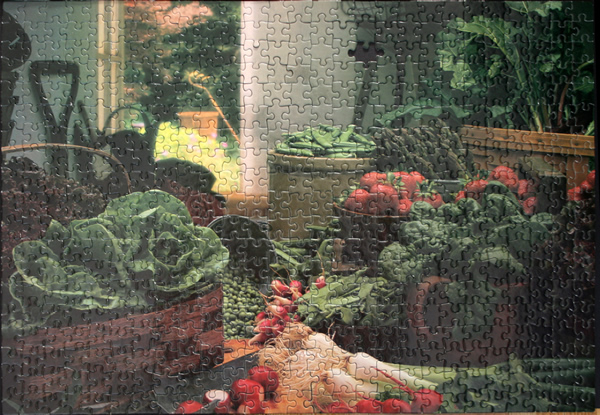
Size: 500 pieces, 1 missing
Dimensions: 35.24cm x 50.48cm
Producer: MB Puzzle, Croxley series, 1997, #4611-22
Puzzle: Pleasant puzzle, preferably done with good lighting. Lots of green, grey, and brown, but easy enough to assemble. Several bright regions (strawberries, onions, window, and walls) as well as the horizontal and vertical surfaces lay a good foundation to guide the completion of the puzzle.
Produce: Produce is a generalized term for a group of farm-produced crops and goods, and is not limited to fruits and vegetables (i.e. meats, grains, oats, etc. are sometimes considered as produce.) More specifically, the term “produce” often implies that the products are fresh and generally in the same state as where they were harvested. Produce is the main product sold by greengrocers, farmers’ markets, and fruit markets. [Wiki]
Puzzle: Kota Bharu Market

Size: 500 pieces
Dimensions: 48.4cm x 35.5cm
Producer: Sure-Lox, Wonderful World series, #42210-38
Notes: Kota Bharu is a city in Malaysia, is the state capital and Royal City of Kelantan. It is also the name of the territory (jajahan) in which Kota Bharu City is situated. The name means ‘new city’ or ‘new castle/fort’ in Malay. Kota Bharu is situated in the northeastern part of Peninsular Malaysia, and lies near the mouth of the Kelantan River.
This northeastern Malaysian city is close to the Thai border, and is home to many mosques. Also of interest are various museums and the unique architecture of the old royal palace (still occupied by the sultan and sultanah and off-limits to visitors but viewable from outside) and former royal buildings (which can be visited) in the center of town. [Wiki]
Puzzle: Eggplant Scene
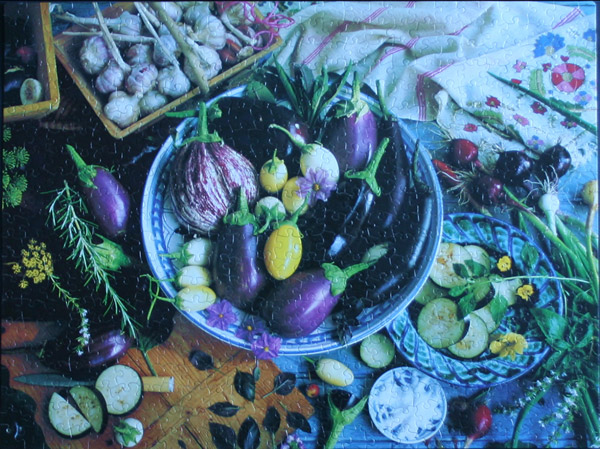
Size: 1000 pieces
Notes: I do not have a record of the producer of the puzzle as I do not have the box anymore. A clarification is welcome – if you have any clue as to the details regarding this puzzle, I would much appreciate that information.
The eggplant, aubergine, melongene, brinjal, or guinea squash (Solanum melongena) is a plant of the family Solanaceae (also known as the nightshades) and genus Solanum. It bears a fruit of the same name, commonly used in cooking. As a nightshade, it is closely related to the tomato and potato and is native to India.
The fruit is botanically classified as a berry, and contains numerous small, soft seeds, which are edible, but are bitter because they contain nicotinoid alkaloids, unsurprising as it is a close relative of tobacco.
The first known written record of the plant is found in Qi min yao shu, an ancient Chinese agricultural treatise completed in 544. The numerous Arabic and North African names for it, along with the lack of the ancient Greek and Roman names, indicate it was introduced throughout the Mediterranean area by the Arabs in the early Middle Ages. [Wiki]
Puzzle: Italian Feast
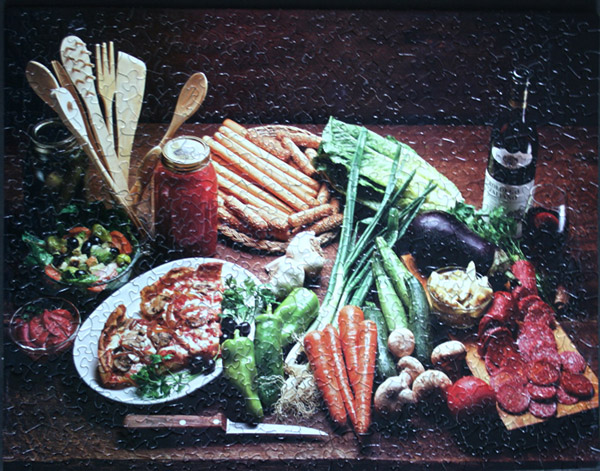
Size: 500 pieces
Dimensions: 35.56 cm x 45.72 cm
Producer: PuzzleMakers International
Box: photo
Notes: An Italian feast opens with antipasti (literally, “before the meal”), or appetizers. The antipasti is followed by the primi, consisting of a light pasta or soup. The main dish, secondi, is a meat or a fish platter. Some recipes will call for braciole, which means cutlets with the bone. The secondi is served with the fourth course in an Italian feast, the contomi, a side dish of vegetables. The Italian meal ends with dolce, equivalent to dessert: pastries like zeppole, served on St. Joseph’s day; doily-like cookies called pizelle; biscottis (twice-baked cookies that give an interesting crunch). Coffee is usually served after the meal. [See Italia site]
There is a book by Antonio Carpuccio called “Italian Feast” that features “a collection of over 100 recipes by Antonio Carluccio, Italian food’s greatest champion, that take the best of the old and the most delicious of the modern to create food that is as full of passion as it is flavour.” [Italian Feast book site]
Puzzle: Nature’s Bounty
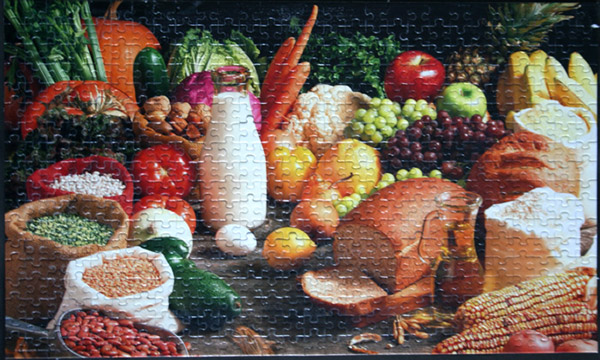
Size: 500 pieces
Producer: RoseArt, Encore series
Notes: bounty (plural bounties)
1. generosity
2. something given liberally
3. A reward for some specific act, especially one given by a government or authority
4. (nautical) formerly, money paid to volunteers for serving in the British navy in time of war





